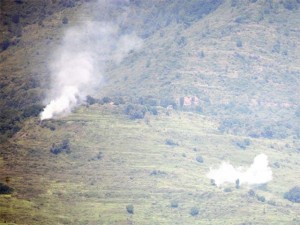Amid the photo ops, a quiet war is still burning
This is the second successive August that India and Pakistan have spent their independence anniversaries – which are a day apart – publicly fulminating about each other. This year, there is unusually steady cross-border firing as well, resulting in the deaths of civilians on either side. In their 69th year as independent countries that share a 2,900-kilometre border and a unique fraternal closeness – DNA, language, food, culture, as well as the colonial experience – it would seem that mutual mistrust has grow rather than any sense of accommodation with the other.
There is a draining of hope that things will change for the better and few expect peace and amity to break out any time soon. As Booker Prize-winning author Arundhati Roy recently told India’s Outlook magazine: “I worry about false-flag ‘terrorist’ attacks and a war with Pakistan, a nuclear war. That’s the kind of suicidal stupidity some of these maniacs on both sides of the border in the government as well as in the media are capable of.”
Even Sunday’s scheduled talks between the two countries’ national security advisers – a first – are seen as just another move on the political chessboard rather than as a chance to untangle snarls in the relationship.
There are many, an accretion that has built up from 1965, when the two countries first went to war over Kashmir. Until then, despite political problems, there had been an expectation of change – India was Pakistan’s largest trade partner right through the 1950s. And between independence in 1947 and 1965, India and Pakistan had entered into 14 agreements related to trade facilitation. No one could have imagined that well into the 21st century, they would still be steeped in the bitter marinade of historical injustice.
But so it has been and for the past 11 days, Indian and Pakistani troops have been trading fire with particular intensity across the Line of Control that serves as the de facto international border in the disputed territory of Kashmir. Politicians and officials have been trading belligerent statements or taking sly potshots at the other. While visiting the UAE earlier this week, for instance, India’s prime minister Narendra Modi named no names but managed to berate Pakistan several times in his speech to Dubai’s packed cricket stadium.
“We tried to bring about unity in SAARC (the South Asian Association for Regional Cooperation),” he said. But he pointedly added: “There will always be some who will be bothered by us. But should we stop work and progress for them?”
Over in Islamabad, India’s deputy high commissioner was summoned to the foreign office and rebuked for the “unprovoked ceasefire violations”.
Last year’s independence celebrations were similarly doleful in terms of cross-border camaraderie. Mr Modi had just called off talks between the two countries’ chief diplomats in a fit of pique at the Pakistani envoy’s temerity in conferring with Kashmiri separatist leaders in India. And he had spent that week snarkily referring to “our neighbour’s attitude” of engaging in a proxy war, while Pakistan retaliated by lamenting the way India had dashed its leaders’ efforts to promote “good, neighbourly relations”. It pointed out that prime minister Nawaz Sharif had attended Mr Modi’s swearing-in ceremony in Delhi in good faith, in pursuit of his vision of peace for development.
This may not be all waffle – Mr Sharif is a businessman, after all – and it brings us to an important, possibly the only, evolution in the India-Pakistan equation. Their leaders are getting better at the optics, of conveying the illusion of talking without negotiating, preferably in settings that produce lots of good photographs.
Mr Modi’s invitation to Mr Sharif to wish him well as he assumed office was a good example of the trend towards engagement that is high on visual impact but low on substance. So, too, their meeting in July, at the Brics summit in the Russian city of Ufa. The men shook hands and spoke in tones of reasonableness about the need to “discuss all outstanding issues” and free each other’s fishermen from jails. They announced that Mr Modi would attend a South Asian summit in Pakistan next year, the first visit by an Indian leader in more than a decade.
But if these seemed like empty gestures, a canny pretence of a peace process, it was because of the absence of an agreed and viable road map – or indeed, any particular hope or expectation of real change.
There have been several efforts at conflict-resolution but none have lasted or produced much. The so-called Composite Dialogue, a structured peace initiative to simultaneously address eight issues including peace and security, Kashmir, water, terrorism and economic cooperation, started in 1998, sporadically flared brightly, then sputtered out after the attacks on Mumbai in 2008. There has been nothing substantial to replace it and there is little indication that either Delhi or Islamabad is working to fill the void.
The absence of a peace plan is complicated by the reality that both countries are nuclear-armed, Indian defence spending has doubled in real terms since 1997 and there is growing pressure on Pakistan to expand its nuclear arsenal to include low-yield warheads and short-range delivery systems.
A recent paper by Walter Ladwig of the department of war studies at King’s College London only adds to the debilitating sense of a region that is doomed to battle-ready hostility or outright war. He says India’s conventional military superiority over Pakistan is exaggerated and it cannot “achieve strategic surprise against Pakistan or carry out highly effective air strikes with little escalatory risk”.
It is, as some describe the stalemate, an “ugly stability”, unrelieved for now by any real attempt to make peace.
Rashmee Roshan Lall is an itinerant writer on world affairs
On Twitter: @rashmeerl


